澳大利亚学校教育中英文介绍
- 格式:doc
- 大小:28.50 KB
- 文档页数:3
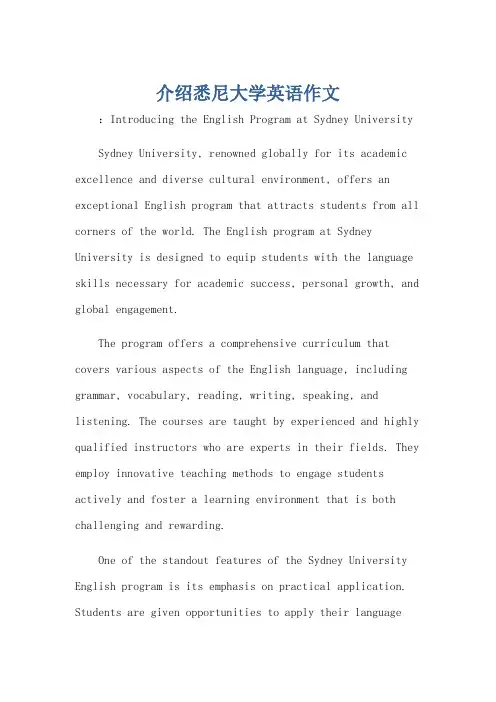
介绍悉尼大学英语作文:Introducing the English Program at Sydney University Sydney University, renowned globally for its academic excellence and diverse cultural environment, offers an exceptional English program that attracts students from all corners of the world. The English program at Sydney University is designed to equip students with the language skills necessary for academic success, personal growth, and global engagement.The program offers a comprehensive curriculum that covers various aspects of the English language, including grammar, vocabulary, reading, writing, speaking, and listening. The courses are taught by experienced and highly qualified instructors who are experts in their fields. They employ innovative teaching methods to engage students actively and foster a learning environment that is both challenging and rewarding.One of the standout features of the Sydney University English program is its emphasis on practical application. Students are given opportunities to apply their languageskills in real-world settings, such as through role-play simulations, group discussions, and presentations. This approach not only enhances students' language proficiency but also prepares them for the demands of academic and professional life.The program also places a strong emphasis on cultural understanding and global perspectives. Students are encouraged to explore the rich cultural heritage of Australia and Sydney, which adds a unique dimension to their language learning experience. They also have the opportunity to interact with students from diverse backgrounds, fostering cross-cultural understanding and appreciation.Moreover, Sydney University provides excellent support services for its English students. The university has a dedicated student support team that offers guidance and assistance in areas such as course selection, academic planning, and personal development. Students can also access a range of resources, including libraries, language labs, and online learning platforms, to enhance their learning experience.The English program at Sydney University is also recognized globally for its high standards and quality. The university's accreditation and partnerships with various organizations worldwide further underscore its reputationin the field of English language education.In conclusion, the English program at Sydney University offers an exceptional learning experience that combines rigorous academic training with practical application and cultural understanding. It prepares students for success in academic and professional settings while fostering a global perspective and appreciation for diverse cultures. Whether you're aiming to improve your English skills for personal or professional reasons, the Sydney University English program is an excellent choice.**文章标题**:介绍悉尼大学英语课程悉尼大学以其卓越的学术水平和多元的文化环境享誉全球,其英语课程也因其卓越的教学质量吸引了来自世界各地的学子。
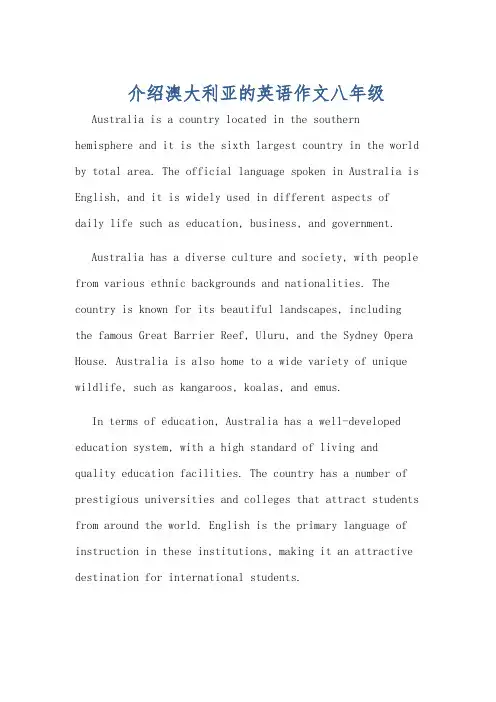
介绍澳大利亚的英语作文八年级Australia is a country located in the southern hemisphere and it is the sixth largest country in the world by total area. The official language spoken in Australia is English, and it is widely used in different aspects ofdaily life such as education, business, and government.Australia has a diverse culture and society, with people from various ethnic backgrounds and nationalities. The country is known for its beautiful landscapes, including the famous Great Barrier Reef, Uluru, and the Sydney Opera House. Australia is also home to a wide variety of unique wildlife, such as kangaroos, koalas, and emus.In terms of education, Australia has a well-developed education system, with a high standard of living andquality education facilities. The country has a number of prestigious universities and colleges that attract students from around the world. English is the primary language of instruction in these institutions, making it an attractive destination for international students.As for the economy, Australia is a prosperous and developed country with a strong economy. It is known for its natural resources, such as coal, iron ore, and gold, which contribute significantly to the country's economy. The country also has a thriving tourism industry, with millions of visitors coming to Australia each year to explore its natural wonders and vibrant cities.总之,澳大利亚是一个多元化的国家,拥有美丽的风景和丰富的文化。
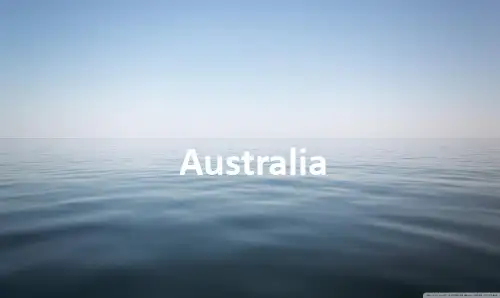

澳洲私立中学介绍之凯瑞文法学校墨尔本凯瑞文法学校(CareyBaptistGrammarSchool)是一所由教会创办的私立混合国际学校,位于澳大利亚墨尔本市的东区,环境优美,安静安全,交通便利,有地铁、有轨电车和公共巴士直达学校,吸引了来自世界十五个以上国家的学生。
墨尔本凯瑞文法学校(CareyBaptistGrammarSchool)八十多年历史,在师资力量、学术质量、学校设备和设施等方面均名列墨尔本最优秀中学前茅,每年的高中毕业生99%都能进入大学就读。
基本信息墨尔本凯瑞文法学校CareyBaptistGrammarSchool基本信息学校性质私立学院(男女混校)成立时间1923 年地点维多利亚州墨尔本市, KEW 校区离市中心 8 公里规模 / 设施Kew 和 Donvale 两个校区, KEW校区提供从幼儿园到 12 年级所有课程。
Donvale 校区提供幼儿园到 6 年级课程。
10 和 11年级接受海外学生申请(KEW校区),需 AEAS 成绩。
最近的机场墨尔本国际机场(距离墨尔本CBD 以西 23 公里左右)学生人数2285 人( KEW 校区有 2000 多学生),国际学生 60 人平均班级人数平均 25 人师生比例约 1:15教职员工超过350 人,学校每年花费近45 万澳币用于师资力量培训发展宗教信仰基督教HSP 课程由 Holmes 学院提供校园设施校内设有Ross H. Miikan 大楼、 Jeffrey O. Thomas 庭院、食堂、图书馆等教学环境,有专业的员工和牧师给学生提供指导运动项目Carey Sports Complex 综合体育馆,占地14 公顷。
有 5 大活动区域,可以玩板球、足球、橄榄球、垒球以及其他户外活动;1 个大型室内体育馆; 3 个排球场地、 8 个羽毛球运动场地、 10 条 400 米 田径跑道、8 水道 25 米 温水泳池和健身房等课外活动 有 22 个运动项目和比赛可供选择,学校有十几个运动俱乐部:包括篮球、赛艇、板球、足球、曲棍球、艺术体操、橄榄球、垒球、雪上运动和网球等俱乐部住宿 寄宿家庭 Homestay学费 A$ 24196 ( 10 年级)A$ 25022 ( 11 年级),A$ 25146 ( 12 年级),申请费A$ 100办学理念( Motto ) 鼓励所有师生在凯瑞享受学习、尊重彼此、热爱生命Learning at Carey will takeplace in a challengingeducational community inwhich all members areencouraged to enjoy learning,respect each other and lovelife学校性质 私立学院(男女混校)成立时间 1923 年地点 维多利亚州 墨尔本市, KEW 校区离市中心 8 公里规模 / 设施 Kew 和 Donvale 两个校区, KEW校区提供从幼儿园到 12 年级所有课程。

介绍澳大利亚的英语作文小学Australia is a beautiful country with a rich history and diverse culture. It is the sixth largest country in the world by land area and is known for its stunning landscapes, unique wildlife, and laid-back lifestyle.The official language of Australia is English, and it is spoken by the majority of the population. AustralianEnglish has its own unique accent and vocabulary, which can sometimes be confusing for non-native speakers.In addition to English, Australia is also home to many Indigenous languages, reflecting the country's rich Aboriginal heritage. These languages are an important partof Australia's cultural identity and are actively preserved and promoted by the government and various organizations.Australia has a high standard of education, and Englishis a core subject in the school curriculum. Students are taught to read, write, and speak English from a young age, and there are also programs in place to support students who are learning English as a second language.Overall, English plays a crucial role in Australia's social, cultural, and economic life. It is the language of communication, education, and business, and being proficient in English is essential for success in many areas of Australian society.澳大利亚是一个美丽的国家,拥有丰富的历史和多元文化。
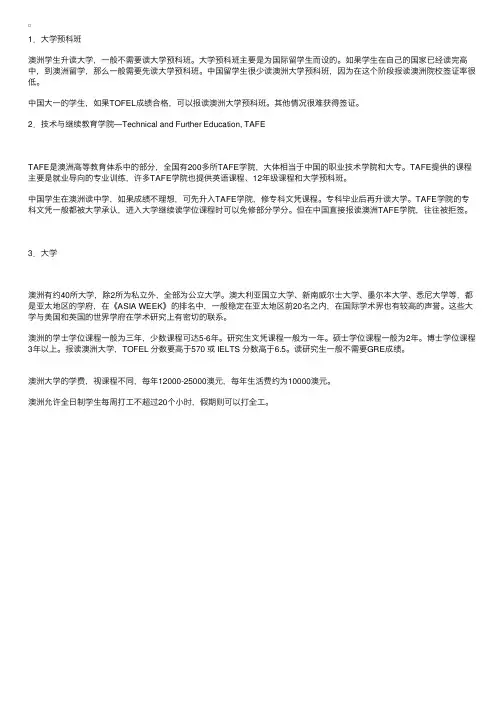
1.⼤学预科班澳洲学⽣升读⼤学,⼀般不需要读⼤学预科班。
⼤学预科班主要是为国际留学⽣⽽设的。
如果学⽣在⾃⼰的国家已经读完⾼中,到澳洲留学,那么⼀般需要先读⼤学预科班。
中国留学⽣很少读澳洲⼤学预科班,因为在这个阶段报读澳洲院校签证率很低。
中国⼤⼀的学⽣,如果TOFEL成绩合格,可以报读澳洲⼤学预科班。
其他情况很难获得签证。
2.技术与继续教育学院—Technical and Further Education, TAFETAFE是澳洲⾼等教育体系中的部分,全国有200多所TAFE学院,⼤体相当于中国的职业技术学院和⼤专。
TAFE提供的课程主要是就业导向的专业训练,许多TAFE学院也提供英语课程、12年级课程和⼤学预科班。
中国学⽣在澳洲读中学,如果成绩不理想,可先升⼊TAFE学院,修专科⽂凭课程。
专科毕业后再升读⼤学。
TAFE学院的专科⽂凭⼀般都被⼤学承认,进⼊⼤学继续读学位课程时可以免修部分学分。
但在中国直接报读澳洲TAFE学院,往往被拒签。
3.⼤学澳洲有约40所⼤学,除2所为私⽴外,全部为公⽴⼤学。
澳⼤利亚国⽴⼤学、新南威尔⼠⼤学、墨尔本⼤学、悉尼⼤学等,都是亚太地区的学府,在《ASIA WEEK》的排名中,⼀般稳定在亚太地区前20名之内,在国际学术界也有较⾼的声誉。
这些⼤学与美国和英国的世界学府在学术研究上有密切的联系。
澳洲的学⼠学位课程⼀般为三年,少数课程可达5-6年。
研究⽣⽂凭课程⼀般为⼀年。
硕⼠学位课程⼀般为2年。
博⼠学位课程3年以上。
报读澳洲⼤学,TOFEL 分数要⾼于570 或 IELTS 分数⾼于6.5。
读研究⽣⼀般不需要GRE成绩。
澳洲⼤学的学费,视课程不同,每年12000-25000澳元,每年⽣活费约为10000澳元。
澳洲允许全⽇制学⽣每周打⼯不超过20个⼩时,假期则可以打全⼯。
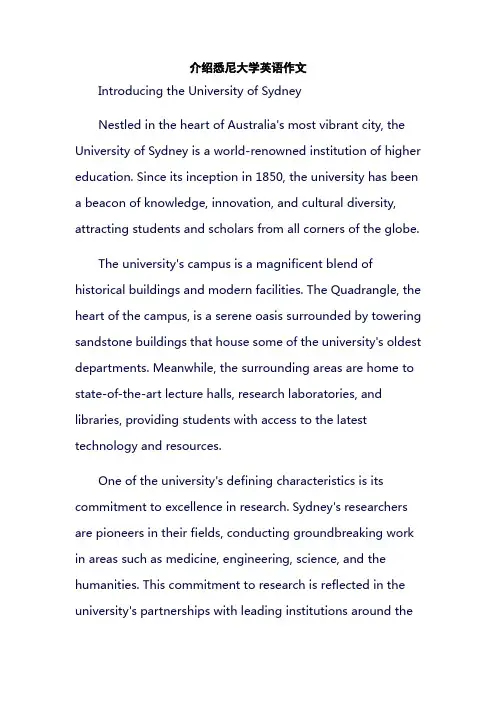
介绍悉尼大学英语作文Introducing the University of SydneyNestled in the heart of Australia's most vibrant city, the University of Sydney is a world-renowned institution of higher education. Since its inception in 1850, the university has been a beacon of knowledge, innovation, and cultural diversity, attracting students and scholars from all corners of the globe.The university's campus is a magnificent blend of historical buildings and modern facilities. The Quadrangle, the heart of the campus, is a serene oasis surrounded by towering sandstone buildings that house some of the university's oldest departments. Meanwhile, the surrounding areas are home to state-of-the-art lecture halls, research laboratories, and libraries, providing students with access to the latest technology and resources.One of the university's defining characteristics is its commitment to excellence in research. Sydney's researchers are pioneers in their fields, conducting groundbreaking work in areas such as medicine, engineering, science, and the humanities. This commitment to research is reflected in the university's partnerships with leading institutions around theworld, as well as its contribution to the development of new technologies and treatments that benefit society.The university's academic programs are equally impressive. Sydney offers a diverse range of undergraduate, postgraduate, and research degrees across a wide range of disciplines. Whether students are interested in the arts, humanities, social sciences, or STEM subjects, they can find a program that suits their interests and ambitions at Sydney. The university's teaching staff are experts in their fields, and they are passionate about sharing their knowledge and expertise with students.In addition to its academic and research excellence, the University of Sydney is also renowned for its vibrant student life. The university's campus is a hub of cultural and social activities, with a wide range of clubs, societies, and events available for students to participate in. Whether students are interested in sports, music, drama, or politics, they can find a group or activity that caters to their interests at Sydney.Finally, the university's location in Sydney is a major drawcard for many students. Sydney is a bustling city with a rich cultural heritage, a vibrant arts scene, and an array ofnatural wonders. Students can explore the city's museums, galleries, and theatres, as well as enjoy the beautiful beaches, parks, and harbors that make Sydney such a desirable place to live and study.In conclusion, the University of Sydney is a world-class institution that offers students an unparalleled academic experience. Its commitment to excellence in research, diverse range of academic programs, vibrant student life, and idyllic location make it a highly sought-after destination for students from around the world.。
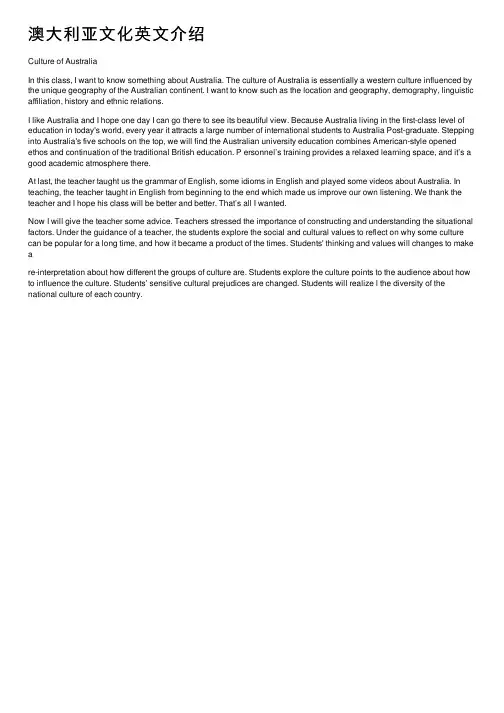
澳⼤利亚⽂化英⽂介绍Culture of AustraliaIn this class, I want to know something about Australia. The culture of Australia is essentially a western culture influenced by the unique geography of the Australian continent. I want to know such as the location and geography, demography, linguistic affiliation, history and ethnic relations.I like Australia and I hope one day I can go there to see its beautiful view. Because Australia living in the first-class level of education in today's world, every year it attracts a large number of international students to Australia Post-graduate. Stepping into Australia's five schools on the top, we will find the Australian university education combines American-style opened ethos and continuation of the traditional British education. P ersonnel’s training provides a relaxed learning space, and it’s a good academic atmosphere there.At last, the teacher taught us the grammar of English, some idioms in English and played some videos about Australia. In teaching, the teacher taught in English from beginning to the end which made us improve our own listening. We thank the teacher and I hope his class will be better and better. That’s all I wanted.Now I will give the teacher some advice. Teachers stressed the importance of constructing and understanding the situational factors. Under the guidance of a teacher, the students explore the social and cultural values to reflect on why some culture can be popular for a long time, and how it became a product of the times. Students' thinking and values will changes to make are-interpretation about how different the groups of culture are. Students explore the culture points to the audience about how to influence the culture. Students’ sensitive cultural prejudices are changed. Students will realize l the diversity of the national culture of each country.。
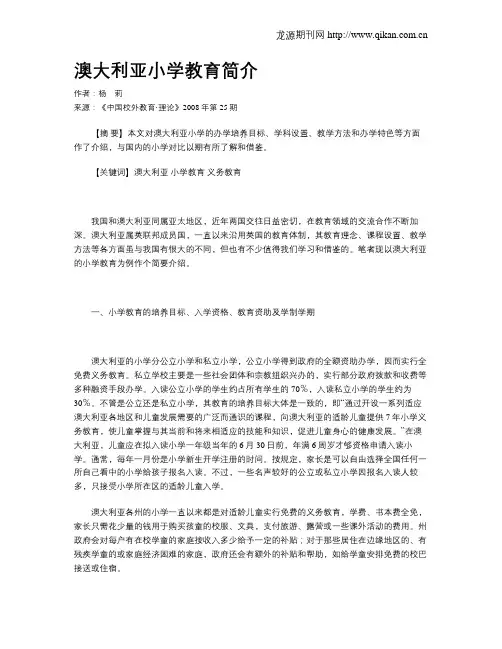
澳大利亚小学教育简介作者:杨莉来源:《中国校外教育·理论》2008年第25期【摘要】本文对澳大利亚小学的办学培养目标、学科设置、教学方法和办学特色等方面作了介绍,与国内的小学对比以期有所了解和借鉴。
【关键词】澳大利亚小学教育义务教育我国和澳大利亚同属亚太地区,近年两国交往日益密切,在教育领域的交流合作不断加深。
澳大利亚属英联邦成员国,一直以来沿用英国的教育体制,其教育理念、课程设置、教学方法等各方面虽与我国有很大的不同,但也有不少值得我们学习和借鉴的。
笔者现以澳大利亚的小学教育为例作个简要介绍。
一、小学教育的培养目标、入学资格、教育资助及学制学期澳大利亚的小学分公立小学和私立小学,公立小学得到政府的全额资助办学,因而实行全免费义务教育。
私立学校主要是一些社会团体和宗教组织兴办的,实行部分政府拨款和收费等多种融资手段办学。
入读公立小学的学生约占所有学生的70%,入读私立小学的学生约为30%。
不管是公立还是私立小学,其教育的培养目标大体是一致的,即“通过开设一系列适应澳大利亚各地区和儿童发展需要的广泛而通识的课程,向澳大利亚的适龄儿童提供7年小学义务教育,使儿童掌握与其当前和将来相适应的技能和知识,促进儿童身心的健康发展。
”在澳大利亚,儿童应在拟入读小学一年级当年的6月30日前,年满6周岁才够资格申请入读小学。
通常,每年一月份是小学新生开学注册的时间。
按规定,家长是可以自由选择全国任何一所自己看中的小学给孩子报名入读。
不过,一些名声较好的公立或私立小学因报名入读人较多,只接受小学所在区的适龄儿童入学。
澳大利亚各州的小学一直以来都是对适龄儿童实行免费的义务教育,学费、书本费全免,家长只需花少量的钱用于购买孩童的校服、文具,支付旅游、露营或一些课外活动的费用。
州政府会对每户有在校学童的家庭按收入多少给予一定的补贴;对于那些居住在边缘地区的、有残疾学童的或家庭经济困难的家庭,政府还会有额外的补贴和帮助,如给学童安排免费的校巴接送或住宿。
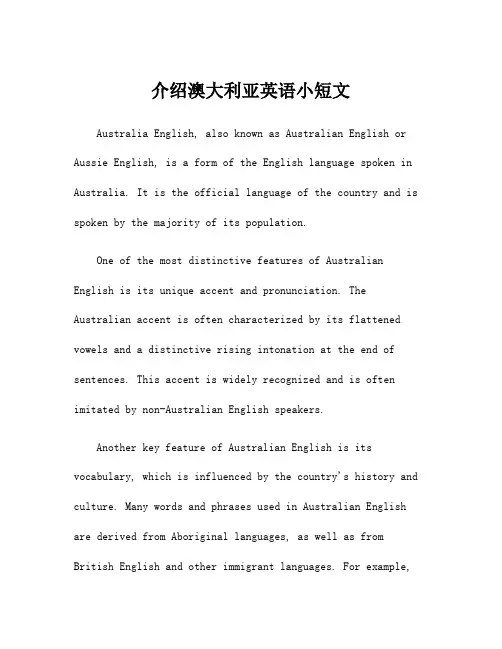
介绍澳大利亚英语小短文Australia English, also known as Australian English or Aussie English, is a form of the English language spoken in Australia. It is the official language of the country and is spoken by the majority of its population.One of the most distinctive features of Australian English is its unique accent and pronunciation. The Australian accent is often characterized by its flattened vowels and a distinctive rising intonation at the end of sentences. This accent is widely recognized and is often imitated by non-Australian English speakers.Another key feature of Australian English is its vocabulary, which is influenced by the country's history and culture. Many words and phrases used in Australian English are derived from Aboriginal languages, as well as from British English and other immigrant languages. For example,Australians commonly use the word "mate" as a friendly term of address, and the phrase "no worries" to express a laid-back attitude.In addition to its accent and vocabulary, Australian English also has its unique grammar and syntax. For example, it is common for Australians to use the present tense in place of the past tense in certain situations, such as "I was with my mates yesterday" instead of "I have been with my friends yesterday." There are also some unique Australian slang and idioms, such as "G'day" for "good day" and "fair dinkum" for "genuine" or "real."Australian English is also known for its use of diminutives, where words are shortened or modified toindicate affection or informality. For example, "barbecue" becomes "barbie," "mosquito" becomes "mozzie," and "sunglasses" becomes "sunnie."The influence of Aboriginal languages on Australian English is also significant, with many words and phrases borrowed from indigenous languages. Some examples include "kangaroo," "boomerang," and "billabong." These words have become a part of everyday vocabulary in Australia and are used by English speakers around the world.In recent years, Australian English has also been influenced by the increasing multiculturalism of the country. Words and phrases from languages such as Italian, Greek, Chinese, and Arabic have been incorporated into Australian English, reflecting the diverse immigrant communities in the country.Overall, Australian English is a rich and diverse form of the English language, shaped by the country's history, culture, and geography. Its unique accent, vocabulary, grammar, and syntax make it a fascinating and distinctivevariety of English, reflecting the identity and character of the Australian people.。
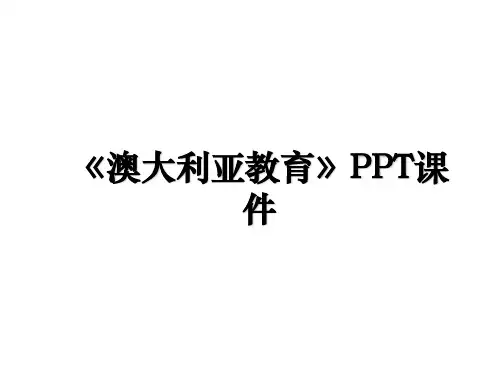
一、学制结构澳大利亚的基础教育为十三年学制,由五岁起入读幼儿园或预备班,其后是十二年的中、小学课程。
大部分州的中学由第七年开始,小学、中学和高中提供义务教育。
小学和中学都是免费的,但可能需要家长支付一些额外的费用,如校服、课本或文具费等。
二、公立与私立学校并存澳大利亚的公立学校由澳大利亚政府提供经费,遍布全国各地,约72%的儿童在政府办的公立学校上学。
公立学校不收学费,但可能需要家长支付一些额外费用。
私立学校可从政府得到部分经费,但收取学费和其他额外费用。
公立学校和私立学校都遵守所在州或领地的课程大纲。
三、课程设置澳大利亚学校依据全国统一的课程大纲设定八个主要范畴的科目:英语、数学、科学、健康与体育、技术、社会及环境学、英语以外其他语言及艺术。
学校对于传统学科的教育,如英语、数学、科学及社会科学等一般更为重视。
四、教育行政管理澳大利亚的教育行政管理为中央与地方共同合作制。
中央教育行政由联邦就业、教育与培训部管理;地方教育行政采取州和地区二级管理形式,州设教育部,下设地区教育管理系统。
联邦就业、教育与培训部通过各专门机构和委员会,实施对各级各类教育的指导和资助,制定全国性的教育政策和就业培训规划。
五、入学政策在澳大利亚,经过正式评断和鉴定的儿童可以早于规定的时间就读。
此外,天资卓越的学生可以跳级或提早就读高年级课程。
某些州和领地允许学生在家就读,尤其是农村地区。
六、教育质量澳大利亚的教育质量较高,成人识字率为98.5%。
全国已基本普及中等教育,12岁~16岁少年入学率为85%,共有中小学生277万人;大学在校生为48.09万人,每10万人中有大学生3025人。
七、学校文化澳大利亚的学校在规章制度上更加严格,大多学校有校服。
文化上偏英式,课外活动丰富,有利于学生的全面发展。
总之,澳大利亚学校教育制度具有学制结构合理、公立与私立学校并存、课程设置丰富、教育行政管理高效、入学政策灵活、教育质量高、学校文化特色鲜明等特点。
澳大利亚学校教育制度特点澳大利亚的教育制度是以政府为主导的公立教育体系,同时也有一些私立学校。
其中,公立学校的数量和规模是最大的。
澳大利亚的教育制度为学生提供了多元化的学习选择,并注重学生的综合素质发展。
教育阶段分明澳大利亚的教育制度,首先表现在教育阶段上的分明性。
澳大利亚的教育制度分为小学(Primary School)、中学(Secondary School)和大学(Tertiary Education)三个阶段。
小学学制是六年,中学学制是六年,高级中学学制是两年。
教育从小学开始,直到高中毕业,是12年的制度。
小学教育是6-12岁的基础教育阶段,包括读写、数学、科学、社会研究等学科。
这个阶段注重培养学生的基本认知能力、沟通技巧和社交能力。
中学教育是12-18岁的教育阶段,学生学习各种学科,并且在这个阶段进行高中毕业考试(Higher School Certificate)的考试,这个考试对于学生进入大学以及未来的职业发展都有非常重要的影响。
大学教育是18岁以上的高等教育阶段,大学教育分为学士、硕士、博士三个阶段。
语言、商科、科技和医学等领域都可以选择专业。
公办和私立学校并存澳大利亚的教育制度,其次表现在公办和私立学校的并存上。
在澳大利亚,公立学校在教育领域扮演着主导地位。
据统计,公立学校占据了澳大利亚大部分的学生人数。
同时,澳大利亚也有一些私立学校,这些学校的教育质量和设施比公立学校更为优越。
许多中产阶级的家庭会选择发送孩子去私立学校,这些学校会为学生提供更好的资源、高质量的教育和更小的班级规模等优势。
重视多元化学习选择澳大利亚的教育制度,第三表现在学生学习选择的多元化上。
在澳大利亚,学生可以根据自己的兴趣、能力和职业目标来选择自己的学习方向。
澳大利亚的教育制度注重学生的专业选择,鼓励学生在高中时选修自己感兴趣的学科,为未来的职业目标做准备。
此外,澳大利亚的教育体系对于非传统的教育途径也非常开放。
介绍悉尼大学英文作文The University of Sydney is one of the most prestigious and renowned educational institutions in Australia. Established in 1850, it is the oldest university in the country and has a long and storied history of academic excellence. Located in the heart of the vibrant city of Sydney, the university boasts a stunning campus that seamlessly blends historic architecture with modern facilities, creating an environment that is both intellectually stimulating and visually captivating.At the core of the University of Sydney's identity is its commitment to providing a world-class education to its students. The university offers a vast array of undergraduate and postgraduate programs across a wide range of disciplines, including the arts, sciences, business, law, medicine, and engineering, among others. Each program is designed to challenge and inspire students, equipping them with the knowledge, skills, and critical thinking abilities necessary to thrive in their chosen fields.One of the hallmarks of the University of Sydney's educationalapproach is its emphasis on research-led teaching. The university is home to a thriving research community, with faculty members who are at the forefront of their respective fields. This research-driven ethos is seamlessly integrated into the curriculum, allowing students to engage with cutting-edge ideas and participate in groundbreaking projects. Whether it's exploring the latest advancements in renewable energy, delving into the complexities of global politics, or unraveling the mysteries of the human mind, the University of Sydney provides ample opportunities for students to be at the forefront of discovery and innovation.The university's commitment to excellence extends beyond the classroom, as it also boasts a vibrant and diverse campus life. Students can choose from a wide range of extracurricular activities, from sports teams and cultural clubs to student organizations and volunteer initiatives. These opportunities not only allow students to pursue their passions and interests outside of their studies but also foster a strong sense of community and camaraderie among the student body.One of the most impressive aspects of the University of Sydney is its global reach and influence. The university has established partnerships and collaborations with leading institutions around the world, providing students with the chance to participate in exchange programs, study abroad opportunities, and international researchprojects. This global perspective helps to prepare students for the challenges and opportunities of an increasingly interconnected world, equipping them with the cultural awareness, language skills, and adaptability needed to thrive in a globalized society.The University of Sydney's commitment to excellence is not limitedto its academic programs and campus life. The university also plays a vital role in the broader community, serving as a hub for public engagement, cultural enrichment, and social impact. Through its extensive outreach initiatives, the university provides a platform for public lectures, workshops, and community events, fostering a deeper understanding and appreciation of the arts, sciences, and humanities among the general public.Moreover, the University of Sydney is deeply committed to the principles of sustainability and environmental stewardship. The university has implemented a range of initiatives aimed at reducing its carbon footprint, promoting renewable energy, and fostering a culture of sustainability among its students, faculty, and staff. From the installation of solar panels to the implementation of waste reduction programs, the University of Sydney is leading by example and inspiring others to take action in the fight against climate change.In conclusion, the University of Sydney is a truly remarkableinstitution that embodies the highest standards of academic excellence, research innovation, and community engagement. Its rich history, global reach, and unwavering commitment to the betterment of society make it a truly unique and inspiring place of learning. Whether you are a prospective student, a researcher, or a member of the broader community, the University of Sydney offers a wealth of opportunities to engage, grow, and make a lasting impact on the world around you.。
澳大利亚教育系统Australian Education System Everything You Need to know!Hey friends. What’s up? I hope you all are engaged in useful activities. Today I am going to talk about the Australian education system. This article will be helpful for both local as well as overseas people. As we all know, education has become a basic need. It is imperative that everyone should have access to education. The Australian education system is distinctive from other countries. The duty of regulation and funding of education is of States. Federal Government also provides funds.The Department of Education & Training is the responsible Australian education system. Australia has an organised and well-structured education system. Education in Australia commences at the age of five or six.After reading this article, you will be an informed person about the Australian education system. Be ready to take an exciting journey with me.In this article, you will get to know about the following points:● Structure of the Australian education system ● Vocational Education and Training● The Australian Qualifications frameworkStructure of the Australian Education SystemThe Australian education system is highly privatized. This fact is true for both the school and higher education sectors.The Australian education system is broadly structured as follows:1. PreschoolPreschools are generally not regulated by the government. Also, it is not compulsory to attend preschools. The first exposure that many kids have to learn is day-care or preschool. Although, this activity is not considered schooling. This is because preschool education is separate from primary school. Preschools approach varies with different states. Some preschools operating separately and some within the primary school.In Australia, preschool is different from primary school. However, in Western Australia and Victoria this is not the case. Preschool is offered to three to five years old.At preschool, children engaged in different activities. These include painting and pasting, blocks and construction, puzzles and games, etc. These activities help children to learn through play. They also help children to develop socializing skills.The role of preschools is to prepare students for school. Also, preschool provides care and supervisions of children. Preschool is the foundation to formal learning.2. Primary schoolPrimary school can be referred to as the first stage of formal education. It is compulsory for children to start school at the age of six years. However, many children start schooling at four or five years of age. Children attend primary school until the age of eleven or twelve. Programs offered by primary schools is the foundation to Year 6 to 7.Since 2010, it has been made compulsory for every student to complete year 10. After that, they are to participate in full time in education or employment, until they are at least 17 years of age.In primary schools, children start to learn core subjects. The primary focus is on providing fundamental knowledge about the world aroundthem. Children are taught essential numeracy and literacy.In some states, middle schools have been introduced. It mainly offers programs for students in Years 7 to 10. But, this could be different from school to school. After completing middle school, students enrol in high or secondary schools to complete year 10, 11 and 12.3. Secondary schoolChildren attend secondary school after completing six years of primary education. Some states have only primary and secondary schools. Children residing in such states and between 13 and 18 years of age attend secondary schools (or high schools.) As you move from primaryschool to secondary school, they are introduced to the more in-depth knowledge of a subject.Students learn about different subjects such as English, math, social science, citizenship, and economics. The curriculum is set to enhance their knowledge about various topics.In year 11 and 12, students have freedom of choice about which subject they want to pursue. Students are awarded a Senior Secondary Certificate of Education once they complete Year 12.After secondary school, students either pursue vocational and higher education courses or start work.4. Higher EducationHigher Education typically involves study at the university or technical college. It relies upon many education providers such as colleges and other institutes. Higher education providers are established or recognized by the Australian governmentHigher education requires rigorous study over a number of years. But some of you may be wo ndering “Why higher education is important?” Let me give you the answer. Higher education not only provides recognized education but also prepares you for future job prospects. Interesting? Right?Australia is one of the most-liked destinations for higher education. The diversity of programs in higher education is like the norm in Australia.There is a wide range of courses to pursue. These courses are highly reputed and internally recognized.Australia is home to 43 universities: 40 are public, two are glo bal, and one private. It’s a perfect place to get a highly recognized education.Vocational Education and Training (VET) VET can be referred to as education and training. More precisely, training that focuses on providing essential skills for work. Thousands of courses are available through the VET.VET provides the essential skills to help students to:Join the workforce for the first time● Re-join the workforce after the break● Upgrade skills in their chosen field● Move into a different careerWho offers VET?Courses affiliated to VET are offered by Registered Training Organizations (RTOs). Technical and further education (TAFE) institutes and private colleges are also included in RTOs. Some universities provide VET courses in addition to higher education courses. Each Australian state or territories register these organizations.Overseas students can also register themselves in VET courses. RTOs that wish to enrol overseas students must also register with the Australian’s government commonwealth registerof institutions and courses for overseas students (CRICOS). Through this, the government monitors the education offered to overseas students in Australia.How do VET courses differ from higher education courses?VET courses are more focused on providing job-oriented skills and practical training. While higher education is known for focusing on delivering theory-based knowledge. Usually, VET courses help students to acquire jobs skills without having higher education.Entry RequirementsEntry into VET requires a student to complete a certain level of study. In Australia, study level equivalent to year 10, 11 and 12 suffices topursue VET courses. But some subjects require earlier work experience. Entry into courses like arts and design may also need a portfolio. Though there are common entry requirements for VET courses, each institute has different criteria.The Australian Qualifications frameworkAQF is a national policy that decides the standard for educational qualifications. It is governed nationally by the Australian government. The Australian government designed the AQF. The aim behind AQF was to ensure that educational titles across the country are consistent.There are ten levels under AQF. I am going to discuss AQF levels briefly in the following paragraphs:1. Level 1Graduates at Level 1 will be able to do initial work. With knowledge and skills, they will be ready for community involvement and further learning.SkillsGraduates at this level will have foundation technical and cognitive skills to:● Undertake coherent actions● Identify simple issues and problems QualificationThose who complete this level are awarded Certificate I.TimeThis level usually requires 0.5 to 1 year to study.2. Level 2Graduates at this level will have basic factual, technical and procedural knowledge of a specific area.SkillsGraduates at this level will have the necessary technical and communication skills to apply the knowledge. The knowledge of appropriate methods and tools have them too:● Undertake defined activities● Provide solutions to predictable problems QualificationThose who complete this level are awarded Certificate II.TimeThis level usually requires 0.5 to 1 year to study.3. Level 3Students after Graduating at this level will have practical and theoretical knowledge. They instil important skills for work or further learning.SkillsThose who are graduates from this level will have a range of skills. These skills include cognitive, technical and communication. This level graduates select and apply a variety of information and tools to:● Complete routine activities● Provide solutions to predictable and sometimes unpredictable problems. QualificationThose who complete this level are awarded Certificate III.TimeThis level usually requires 1 to 2 years to study.4. Level 4Graduates at this level will have practical and theoretical knowledge and skills for specialized or skilled work.SkillsGraduates at this level will have a broad level of cognitive, technical and communication skills. They apply their knowledge and skills to:● Complete routine and non-routine activities● Provide solutions to predictable and unpredictable problems.QualificationThose who complete this level are awarded Certificate IV.TimeThis level usually requires 0.5 to 2 years of study.5. Level 5Specialized knowledge and skills acquired by the graduates help them to do paraprofessional work.SkillsThey have a broad range of skills which include cognitive, technical and communication skills. The skills help them to select and apply knowledge to:Analyze information● Ability to provide solutions to complex problems● Ability to transmit information to others QualificationsThose who complete this level are awarded a Diploma.TimeThis level usually requires 1 to 2 years of study.6. Level 6Broad knowledge and skills acquired by the graduates at this level help them to do highly skilled workSkillsAgain, like the previous level, students at this level have cognitive, technical and communications skills. Graduates at this level use these skills to:● Analyze complete information and make sense out of it● Interpret and transmit solutions to complex problems● Transmit skills to othersQualificationThose who complete this level are awarded an Associate degree and an Advance diploma.TimeAssociate degree – This level usually requires 2 years of study.Advanced degree –This level usually requires 1.5 to 2 years of study.7. Level 7Broad and coherent knowledge acquired by graduates at this level prepares them for professional work.SkillsWell-developed cognitive, technical and communication skills are some of the traits of graduates at this level. They apply these skills to:● Evaluate and analyze information● Generate, analyze and transmit solutions to complex problems● Share knowledge, skills, and ideas QualificationThose who complete this level are awarded an, Bachelor Degree.TimeThis level usually requires 3 to 4 years of study8. Level 8Student after this level will have advanced knowledge and skills for professional work or highly skilled work.SkillsAdvanced cognitive, technical and communication skills acquired by graduates at this level. These skills help them to select and apply knowledge to:● Analyse the critical information of the complete range of activities● Generate and analyze solutions to complex problems● Transmit knowledgeQualificationThose who complete this level are awarded a Graduate diploma, graduate certificate and Bachelor honours degree.TimeGraduate Diploma – This level usually requires 1 to 2 years of study.Graduate certificate – This level usually requires 6 months to 1 year of study.Bachelor honours degree –This level usually requires 1 year of study.9. Level 9Students after this level will have specialized knowledge, skills and they can use these skills to research and work practice.SkillsStudents who graduate from this level will have specialized knowledge and skills for and professional practice. They can independently:● Reflect on and analyze complex information, problems, concepts and theories● Ability to execute theories into practice● Transmit knowledge and skillsQualificationThose who complete this level are awarded a Masters degree (extended), Masters degree (coursework) and Masters degree (research).TimeMasters degree (extended) – It usually requires 3 to 4 years of study.Masters degree (coursework) and Masters degree (research) – This usually requires 1 to 2 years of study.10. Level 10Students after this level acquire a critical understanding of complex subjects. They go through systematic training to get through this level.SkillsStudents who graduate from this level will have expert and specialized skills. These skills are in the discipline area to:● Engage in appraisal and reflection● Adapt, develop and implement existing research● Promote and generate new insights into the community● Generate genuine and original knowledge to make a significant contributionQualificationThose who complete this level are awarded a Doctoral degree.TimeThis level usually requires 3 to 4 years of study.Get to know more about Masters degree in AustraliaFinal wordsThe Australian education system is one of the most reputed in the world. If you’ve just found a new job or planning to settle, you should know about the Australian education system. Many overseas students are flying to Australia to pursue higher education.。
澳大利亚名校英文介绍Australia is home to some of the world's most prestigious universities, known for their academic excellence, cutting-edge research, and vibrant campus life. In this document, I will introduce some of the top universities in Australia that are renowned for their academic reputation and global impact.One of the most well-known universities in Australia is the University of Melbourne, consistently ranked as one of the top universities in the world. Founded in 1853, the University of Melbourne offers a wide range of undergraduate and postgraduate programs across various disciplines, including arts, sciences, engineering, and business. The university is known for its research excellence and innovative teaching methods, attracting students from all over the world.Another leading institution in Australia is the Australian National University (ANU) located in Canberra,the capital city of Australia. Established in 1946, ANU is renowned for its strong emphasis on research and its commitment to academic excellence. The university offers a diverse range of programs in fields such as politics, economics, law, and environmental studies, attracting top scholars and researchers from around the globe.The University of Sydney is another prestigious institution in Australia with a rich history dating back to 1850. Located in the vibrant city of Sydney, the university is known for its world-class facilities, cutting-edge research, and diverse student population. The University of Sydney offers a wide range of programs in areas such as medicine, engineering, architecture, and humanities, preparing students for successful careers in their chosen fields.Monash University, located in Melbourne, is another top university in Australia known for its innovative research and strong industry connections. With a focus on practical learning and real-world experience, Monash Universityoffers a range of programs in areas such as business, health sciences, technology, and arts. The university's commitment to innovation and entrepreneurship has made it a popular choice for students seeking a dynamic and forward-thinking education.The University of Queensland, located in Brisbane, is renowned for its world-class research and academic excellence. Established in 1909, the university offers a wide range of programs in areas such as science, engineering, agriculture, and humanities. The University of Queensland is known for its strong industry partnerships and commitment to sustainability, preparing students to make a positive impact on the world.In conclusion, Australia is home to some of the world's most prestigious universities, offering a diverse range of programs, cutting-edge research, and vibrant campus life. Whether you are interested in arts, sciences, business, or technology, there is a university in Australia that will meet your academic and career goals. With a strong emphasison innovation, research, and global engagement, Australian universities continue to attract students from around the world seeking a high-quality education and a truly unforgettable experience.。
介绍澳大利亚英语作文小学Embark on a linguistic adventure to the land down under, where the unique charm of Australian English unfolds in the classrooms of its primary schools. Picture this: a vibrant tapestry of accents, colloquialisms, and a rich history woven into the fabric of everyday conversation. Australian English, with its distinct flavor, is not just a language but a cultural experience that captivates young minds.In the primary schools of Australia, the English language is taught with a blend of traditional curriculum and a nod to the local vernacular. Children are introduced to the ABCs with a twist, learning to spell words that are uniquely Australian, like 'kangaroo' and 'boomerang'. They engage in reading exercises that feature stories of the Australian outback, filled with characters that embody the spirit of the land.The classrooms buzz with the sounds of young learners practicing their speech, often peppered with local slang like 'mate' and 'g'day'. Teachers encourage the use of these expressions to foster a sense of belonging and pride in their linguistic heritage. The curriculum also delves into the history of Australian English, tracing its roots back to the English settlers and the Aboriginal languages that have influenced it.Storytelling is a cornerstone of Australian culture, andthis tradition is kept alive in the primary schools. Children are encouraged to create their own stories, often drawing from the rich tapestry of Australian history and folklore. This not only enhances their language skills but alsoinstills a deep appreciation for their cultural identity.Moreover, Australian English is a living language that evolves with the times. In the schools, children are taught to embrace this dynamism, learning to adapt their language to suit different contexts and audiences. This prepares them for the global stage, where they can confidently represent their unique linguistic heritage.In essence, learning English in Australian primary schools is an immersive journey that goes beyond the classroom. It's a celebration of a language that is as diverse and as captivating as the country itself. It's a journey that shapes not just language skills but also the cultural identity of the young learners, setting them on a path to become ambassadors of the rich and colorful Australian English.。
Some of Australia's most prominent and well known schools are based in Melbourne. Of the top twenty high schools in Australia according to the Better Education ranking, six are located in Melbourne.[160] There has also been a rapid increase in the number of International students studying in the city. Furthermore, Melbourne was ranked the world's fourth top university city in 2008 after London, Boston and Tokyo in a poll commissioned by the Royal Melbourne Institute of Technology.[161] Melbourne is the home of seven public universities: the University of Melbourne, Monash University, Royal Melbourne Institute of Technology (RMIT University), Deakin University, La Trobe University, Swinburne University of Technology and Victoria University.
一些澳大利亚最著名的和众所周知的学校是建立在墨尔本。
在澳大利亚的前二十高中排名更好的教育,六个位于墨尔本。
[160]还在国际留学生的数量迅速增加。
此外,墨尔本名列世界第四顶尖大学城市2008年伦敦、波士顿和东京委托进行的一项民意调查皇家墨尔本理工学院。
[161]墨尔本是七个公立大学之家:墨尔本大学、莫纳什大学、墨尔本皇家理工学院(RMIT大学)、迪肯大学、拉筹伯大学、斯文本科技大学和维多利亚大学。
The University of Melbourne, the second oldest university in Australia,[162] was ranked first among Australian universities
in the 2010 THES international rankings.[163] The 2012–2013 Times Higher Education Supplement ranked the University of Melbourne as the 28th (30th by QS ranking) best university in the world.
2012 - 2013年泰晤士报专上教育增刊将墨尔本大学列为28日(QS排名30日)世界上最好的大学。
莫纳什大学被评为第99(QS 排名60)世界上最好的大学。
RMIT University was also ranked among the top 51-100 universities in the world in the subjects of: accounting, communication andmedia studies, computer science and information systems.[165] The Swinburne University of Technology, based in the inner city Melbourne suburb of Hawthorn is ranked 76-100 in the world for Physics by the Academic Ranking of World Universities making Swinburne the only Australian university outside the Group of Eight to achieve a top 100 rating in a science discipline. Deakin University maintains two major campuses in Melbourne and Geelong, and is the third largest university in Victoria. In recent years, the number of international students at Melbourne's universities has risen rapidly, a result of an increasing number of places being made available to full fee paying students.[166] Education in Melbourne is overseen by the
Victorian Department of Education and Early Childhood Development(DEECD), whose role is to 'provide policy and planning advice for the delivery of education'.
皇家墨尔本理工大学也是排在前世界上51 - 100大学的科目:会计、通信andmedia研究,计算机科学和信息系统。
斯文本科技大学[165],位于墨尔本市内郊区的山楂是世界上排名76 - 100为物理世界大学学术排名让斯文本科技大学唯一的澳洲大学外面八国集团100年达到最高评级科学学科。
在墨尔本迪肯大学保持两个主要校园和吉朗,维多利亚和第三大大学。
近年来,墨尔本大学的国际学生数量迅速上升,导致越来越多的地方被提供给学生完整的费用支付。
[166]教育在墨尔本是由维多利亚教育部和儿童早期发展(DEECD),其作用是提供政策和规划建议的教育”。